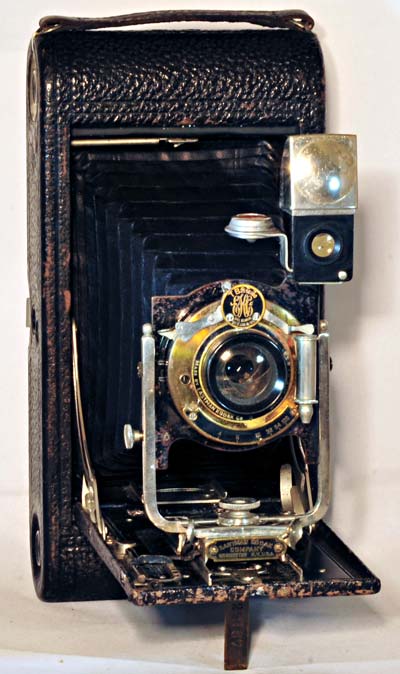No.3-A Folding Pocket Kodak, Model B‑5
Specification

| Manufacturer | : | Kodak (USA) |
|---|---|---|
| Produced | : | 1909-1912 |
| Classification | : | Large Format |
| Body Type | : | Folding bed |
| Bellows Deployment | : | Sliding Rail |
| Construction | : | Wood & Metal |
| Film Type | : | 122 |
| Film Width | : | 3¾ |
| ImageSize | : | 3¼ x 5½ in Postcard Format |
| No. of Images | : | 6 |
| Lens Type | : | Bausch & Lomb Rapid Rectilinear |
| Focus Type | : | Variable |
| Focal Length | : | 165mm |
| Focal Range | : | 6ft - inf. |
| Aperture Type | : | Iris |
| Aperture | : | f/8 - f/45 |
| Shutter Type | : | Kodak Ball Bearing |
| Shutter Speeds | : | T,B,1/25,1/50,1/100 sec |
| Size Closed (w x h x d) | : | 120 x 250 x 50 mm |
| Size Open (w x h x d) | : | 120 x 250 x 205 mm |
| Weight | : | 1.13kg |
Description
This is a very large camera standing 25cm (10") tall. It's name suggests pocket sized but you would need exceptional pockets to get this in.
The body of the camera is constructed in wood, with metal folding bed and back. It produces postcard sized pictures on 122 film. A reflecting finder and spirit level are fitted to lens standard.
To open the front of the camera, you need to find the push button that is hidden beneath the leatherette covering. There is a small embossed circle in the leatherette near the top of the right hand side that locates the button.
The lens standard is deployed on rails and there is an adjustable stop to fix the focussing distance. The focussing range is 2m (6ft) to infinity.
The lens standard can be raised or lowered. You are advised to set the camera level using the built in spirit level. If you are photographing a high building, you should raise the lens rather than tilting the camera upward. If you need more foreground then the lens should be lowered. No guide is given as to how much you should raise or lower the lens making it a bit hit and miss. The lens can also be moved left or right (up or down) when the camera is in the landscape position.
The shutter has 5 modes - T, B, 1/25s, 1/50s, 1/100s. The shutter is released by a lever on the right hand side. There is also a pneumatic release so that a rubber bulb and tube can be attached for remote triggering. A very small counter is found on the lens plate that counts the number of times the shutter has been fired.
The aperture is controlled by a tab and can be varied on a scale of 4 to 128. These are not f numbers but a scale based on the Uniform System (US). The conversion between the US system and f numbers is shown in the table below.
| US | 4 | 8 | 16 | 32 | 64 | 128 |
|---|---|---|---|---|---|---|
| f | 8 | 11 | 16 | 22 | 32 | 45 |
The film advance is controlled by using the red window on the rear. It does not have a cover.
The camera could be purchased with a bespoke leather slip case.
How to Use
Find the manual here :- Kodak 3 & 3A Manual
This camera takes 122 film which is still available as expired film but difficult to find.
It is possible to use 120 film which will give a panoramic result. You will need to purchase 122 to 120 film adapters for Kodak Autographic and Folding Pocket cameras. The other problem is that you can't see the frame numbers through the red window. You will have to count the number of turns of the film winder to ensure you don't get overlapping frames. The red window must be covered with opaque tape at all times.
When you have solved the above problems, and you don't want to bother with an exposure meter, follow the guide shown. It is based on the 'Sunny 16' rule. Film is so forgiving and will produce acceptable results even when overexposed by 2 or 3 stops or underexposed by 1 stop. Number of stops over or under exposure shown in brackets.
Remember that the exposure guide in the camera user manual may not be helpful as it is based on the use of old film with a low ISO value.
The tables assume that the sun is at least 30 degrees above the horizon - that's 10am - 5pm on a summer's day in the UK.
If you are not sure about the light level, err on the side of overexposure - i.e. assume the smaller f number.
Where there is a choice, a larger f number will give a larger depth of field.
For the slower speeds, you may need a tripod to stop blur through shake.
Using ISO 100/125 film
| Weather Conditions | Shadow Detail | Shutter Speed (s) | ||
|---|---|---|---|---|
| 1/25 | 1/50 | 1/100 | ||
 Sunny SunnySnow/Sand | Dark with sharp edges | f/45 | f/32 | f/22 |
 Sunny Sunny | Distinct | f/32 | f/22 | f/16 |
 Slight Overcast Slight Overcast | Soft around edges | f/22 | f/16 | f/11 |
 Overcast Overcast | Barely visible | f/16 | f/11 | f/8 |
 Heavy Overcast Heavy Overcast | None | f/11 | f/8 | f/6.3 |
 Open Shade Open Shade/Sunset | None | f/8 | - | - |